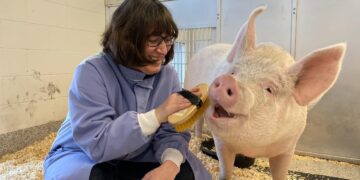Table of Contents
Part 1: The Dream and the Demolition: My Failed Adoption Story
I’m an architect.
My entire professional life is built on a foundation of meticulous planning, of understanding how systems work, and of ensuring that every beam, every wire, and every window contributes to a structure that is sound, functional, and beautiful.
I draw blueprints for a living.
So when I decided to adopt a dog, I assumed the process would be second nature.
I was wrong.
My failure wasn’t just frustrating; it was heartbreaking, and it forced me to demolish everything I thought I knew about bringing an animal home.
My journey started where so many do: scrolling.
I spent hours on the websites of Wellington’s animal shelters, my screen a gallery of hopeful faces.
It felt like browsing a catalogue, an exciting but ultimately superficial act of shopping.
I wasn’t looking for a personality, a temperament, or a set of needs; I was looking for a look.
And then I saw him.
“Max.” A handsome, sable-coated dog with intelligent eyes.
The photo was perfect.
In my mind, I instantly built a story around him—walks along Oriental Bay, lazy Sundays at a Petone café, a loyal companion curled at my feet while I worked.
I fell in love with a two-dimensional image.
The adoption process at the large, busy shelter was a whirlwind.
I filled out the forms, had a brief chat, and soon enough, Max was in my car on the way to my quiet city apartment.
The romantic story I had constructed in my head began to crumble almost immediately.
The Max in my apartment was not the stoic, calm dog from the Photo. He was a bundle of raw, anxious energy.
My quiet home, which I thought was a sanctuary, was a pressure cooker for his unknown history of severe separation anxiety.
Every time I left for work, I would return to a scene of destruction—chewed doorframes, shredded cushions, and the frantic, high-pitched barks that my neighbours politely started to complain about.1
His hyperactivity wasn’t a quirk; it was a desperate cry for an environment I couldn’t provide.
I tried everything the internet suggested: puzzle toys, long runs before work, calming pheromones.
But I was trying to patch cracks in a foundation that was fundamentally flawed.
The truth was, my home was a mismatch for his needs.
My lifestyle, with its long hours at the office, was incompatible with his deep-seated anxiety.
The gut-wrenching realization dawned on me: I hadn’t rescued him; I had simply moved him from one stressful environment to another.
The decision to return Max to the shelter was one of the most difficult I have ever made.
It felt like a profound personal failure.
I had followed the standard advice, I had picked a dog I was drawn to, and it had ended in a way that was painful for both of us.
This experience is, unfortunately, not uncommon.
Many adoptions are returned due to unexpected behaviours, a mismatch in energy levels, or the discovery that the adopter’s home simply isn’t the right fit.1
The return, while devastating, was the most responsible thing I could do for Max.
It was an admission that he deserved a home better suited to him, a home I couldn’t provide.3
That day, driving away from the shelter with an empty passenger seat, I knew I had to question the very blueprint of adoption itself.
Part 2: The Epiphany: Shifting from a Shopper to an Architect
For weeks after returning Max, I was disillusioned.
The dream of companionship had been replaced by the stark reality of my failure.
I had approached the process with the best of intentions, yet the outcome was a disaster.
I avoided the shelter websites, the happy “gotcha day” photos on social media feeling like a personal indictment.
The thought of trying again was terrifying.
The turning point came not from a grand revelation, but from a quiet conversation.
On a whim, I had driven out to a small, foster-based rescue’s adoption day event, more as a spectator than a participant.
I found myself talking to a volunteer from an organization much like Ellie’s Canine Rescue, a group that relies on a network of foster homes rather than a central facility.4
I must have looked lost, because she approached me with a kind smile.
I mumbled something about my experience, about how I’d failed to find the “right dog.”
She listened patiently, then asked a question that changed everything.
She didn’t ask, “What kind of dog are you looking for?” Instead, she asked, “What kind of home can you provide?”
The question was so simple, yet so profound.
It flipped the entire equation on its head.
My first attempt had been all about my desires, my wants, the story I wanted to tell.
Her question forced me to consider my capacity, my limitations, my reality.
It was a shift from consumption to contribution.
Sensing my shift in perspective, she offered me the analogy that would become my new framework.
“Think of it like you’re an architect,” she said.
“You wouldn’t build a house without understanding the land it sits on.
You wouldn’t start hammering without a detailed blueprint.
You wouldn’t use shoddy materials and hope for the best.
A successful, lifelong adoption is the same.
It’s not shopping; it’s an act of architecture.”
This was my epiphany.
The complex, sometimes frustrating adoption processes I had once seen as bureaucratic hurdles were, in fact, essential architectural tools.
The long application forms, the probing questions, the home checks—they weren’t there to judge me.
They were there to force me, the prospective adopter, to stop being a passive consumer and start being a proactive architect.
They are a deliberate system designed to filter out impulsive decisions and to ensure the “build” is successful, because for a rescue operating on shoestring budgets and volunteer time, a failed adoption is a costly structural collapse.5
I suddenly understood that the detailed paperwork was the project’s design brief.
The home visit was the site inspection.
The multi-step process was the construction schedule, with built-in checks to ensure quality and compatibility.
This new paradigm, Adoption as Architecture, gave me a structured, empowering way to approach the journey.
It was a framework built on four key phases:
- The Foundation: Surveying the diverse and complex rescue landscape of Wellington to understand the “terrain.”
- The Blueprint: Conducting an honest, rigorous self-assessment to design a home that is realistic and sustainable.
- The Build: Patiently and respectfully navigating the structured, multi-step adoption process.
- The Final Inspection: Committing to the crucial post-adoption adjustment period and providing ongoing “maintenance.”
Armed with this new model, I wasn’t scared anymore.
I was prepared.
I was ready to stop shopping and start building.
Part 3: The Foundation: Surveying Wellington’s Rescue Landscape
The first step in any architectural project is to survey the site.
You need to understand the topography, the soil composition, the zoning laws, and the available utilities.
Similarly, before you can build a home for an animal, you must understand the landscape of Wellington’s animal welfare ecosystem.
It’s not a monolithic entity; it’s a diverse collection of organizations, each with a unique philosophy, capacity, and purpose, often created to fill gaps left by others in a challenging sector.6
Choosing the right organization to partner with is the foundational decision of your entire adoption journey.
The Civic Institutions (The General Contractors)
These are the large-scale, often council-affiliated organizations that handle a high volume of animals and have broad public mandates.
They are the general contractors of the animal welfare world.
- SPCA Wellington: With a history spanning over 130 years, the SPCA is a cornerstone of animal welfare in the region.8 Located in Newtown, their centre includes not just rehoming facilities but also a full veterinary hospital and an Inspectorate team that investigates cruelty complaints under the Animal Welfare Act 1999.8 Their scale allows them to help a vast number of animals, but it also means they must manage the environment carefully to reduce stress. To this end, they have shifted from walk-in viewings to an appointment-based adoption process. This ensures that staff can dedicate time to matching you with a suitable animal and that the animals themselves aren’t overwhelmed by constant foot traffic.10 It’s important to note that the SPCA in New Zealand is distinct from organizations with the same name in other countries, like South Africa or the US, which have different processes and policies.12
- Council Animal Services (Wellington, Hutt City, Upper Hutt): The city councils’ primary role is not rehoming; it is enforcement and compliance under the Dog Control Act.15 They manage dog registration, respond to complaints, and operate the city pounds. While they do have dogs available for adoption, this is a secondary function, and they often work in partnership with other rescue organizations like the SPCA and HUHA to place suitable dogs.18 Recently, Wellington City Council enhanced its animal services to be more responsive on the road, meaning the Moa Point Animal Shelter is no longer open for public drop-ins and they no longer accept surrendered dogs for rehoming, directing people to other shelters instead.19 This is a critical distinction: adopting from the council is possible, but their capacity and criteria can be more limited than a dedicated rescue.
The “No-Kill” Sanctuaries (The Master Builders)
These organizations are defined by a powerful guiding principle: they provide a home for life.
They are the master builders, committed to seeing a project through to the very end, no matter the cost or complexity.
- HUHA (Helping You Help Animals): HUHA is more than a shelter; it’s a movement. Founded in 2001, their core philosophy is that “Every Animal Matters”.20 They are a no-kill sanctuary, meaning that if an animal cannot be rehomed, it has a safe place to live out its life at one of their sanctuaries in Kaitoke or Otaki.21 This commitment is immense. Beyond rehoming dogs, cats, and rural animals, HUHA is a leader in disaster response, animal welfare advocacy, and community education.20 Their work during the Christchurch earthquakes and Nelson fires is a testament to their “gumboots first” mentality.20 Because of this profound commitment, their adoption process is exceptionally thorough. They offer a lifetime guarantee: if at any point you can no longer care for an animal you adopted from them, they will take it back.23 This is their promise, and it’s why they invest so much time in ensuring the initial match is right. Their vision is expanding, with plans for a new, purpose-built 157-acre sanctuary in rural Wellington, demonstrating their long-term stability and dedication.24
The Specialists (The Artisans)
Just as a large construction project relies on skilled artisans for specific tasks, the Wellington rescue scene thrives on specialized groups that bring deep expertise to a particular niche.
- Foster-Based Networks (Ellie’s Canine Rescue, Outpawed Rescue Trust): These agile organizations operate without a central physical shelter. Instead, rescued animals live in the homes of dedicated volunteers. Ellie’s Canine Rescue, based in the Greater Wellington region, takes in dogs from pounds and private surrenders, placing them in foster care until a permanent home is found.4 This model offers an invaluable advantage: the rescue has detailed knowledge of how the animal behaves in a real home environment—if it’s house-trained, good with kids, or scared of the vacuum cleaner. The trade-off is that these groups are often run entirely by volunteers with full-time jobs, so communication and processing can sometimes take longer. As their website notes, it may take a week or two to hear back, so patience is essential.25 Outpawed Rescue Trust provides a similar foster-based service for cats and kittens in the Wellington region.26
- Species-Specific Shelters (Cats Protection Wellington): For those looking to adopt a feline friend, an organization like Cats Protection Wellington (CPW) offers unparalleled expertise. Located in Kingston, their shelter is intentionally designed to feel like a comfortable house, with sofas and sunny decks, to keep the cats relaxed and happy.27 Their process is tailored specifically to the needs of cats and their prospective owners. They require all members of the household to attend the meet-and-greet, and renters must provide written permission from their landlord.27 This specialization ensures a deep understanding of feline behaviour and needs.
- Niche Guardians (The Black Sheep Animal Sanctuary): To fully appreciate the breadth of Wellington’s animal welfare community, it’s worth knowing about groups like The Black Sheep Animal Sanctuary in Ōtaki. They focus primarily on rescuing and providing refuge for ex-farm animals like sheep, pigs, and cows.28 While you may not be looking to adopt a goat, their existence highlights the powerful ethical principles of animal rights and liberation that underpin much of the independent rescue work in a country with a large agricultural economy.28
Understanding this landscape is your first architectural act.
Are you looking for the broad resources of a General Contractor like the SPCA, the lifelong commitment of a Master Builder like HUHA, or the specialized, in-home knowledge of an Artisan network like Ellie’s? Your answer will determine the path you take.
Part 4: The Blueprint: Designing for a Perfect Fit
Once you’ve surveyed the landscape of Wellington’s rescues, the next architectural phase begins: drawing the blueprint.
This is the most critical and often overlooked step.
It’s not about finding a house you like and trying to squeeze your life into it; it’s about designing a house that fits the life you already have.
A failed adoption is almost always the result of a flawed blueprint—a mismatch between the animal’s needs and the home’s reality.
This section is about conducting an honest, unflinching self-assessment to create a blueprint for success.
Surveying Your Own “Property”
Before you even look at a single photo of an animal, you need to survey your own “property”—your life, your home, your finances, and your family.
The rigorous application forms used by rescues are designed to force this introspection.
They are asking the questions that I failed to ask myself before I brought Max home.
- Lifestyle & Time: How many hours a day will the pet be alone? This is a crucial question on HUHA’s application form.29 My failure with Max was a direct result of underestimating his need for companionship. If you work long hours, a highly social puppy or a dog with separation anxiety is a recipe for disaster. Be honest about your activity level. A promise to start running every day is not a plan. If you’re a homebody, a high-energy breed will be miserable, leading to destructive behaviours and hyperactivity—two of the top reasons for returns.1
- Home Environment: This is a major logistical hurdle. Do you own or rent? This is the first question on many applications.29 Ellie’s Canine Rescue, for instance, states they do not adopt to people in renting situations because of the instability it can create, noting that 80% of the dogs they take in are from rentals.25 Other rescues like HUHA require written permission from your landlord.23 Do not try to hide a pet from a landlord; it’s a leading cause of pet surrender when people are forced to move.30 Is your property securely fenced? For most dog rescues, this is non-negotiable for safety reasons.23 They will ask for details about fence height and type.29
- Financials: Can you truly afford a pet? The initial adoption fee is just the beginning. The average first-year cost for a dog can exceed $3,000, including supplies, food, and routine vet care.1 More importantly, can you afford an emergency? A sudden illness or accident can easily result in a vet bill of $1,000 or more. The inability to afford unexpected medical costs is a heartbreaking but common reason for pets to be returned to shelters.30 Thinking about pet insurance or setting up a dedicated savings account is not a luxury; it’s a fundamental part of a sound architectural plan.
- Family & Other Pets: Is every single person in your household 100% on board with this decision? Rescues like HUHA and Cats Protection Wellington require all household members to be present at the meet-and-greet for this very reason.23 A pet cannot thrive in a home where it is merely tolerated by one member of the family. If you have existing pets, how will you manage the introduction? This needs to be a slow, carefully managed process to avoid conflict and stress.31
Decoding the Application Form
The adoption application can feel like an intrusive interrogation.
But when you view it through the lens of architecture, it becomes a collaborative design document.
It’s the rescue’s way of helping you ensure your blueprint is sound.
Let’s decode some common questions from a form like HUHA’s 29:
- “Who lives with you in the home?” This isn’t just about numbers. It helps the rescue assess the activity level (a quiet retired couple vs. a busy family with young children), potential for allergies, and the stability of the environment.
- “Please describe your current fencing (i.e., fully fenced, fence height etc.).” This is a direct question about safety and liability. An escape-artist dog requires a different level of security than a small, low-energy senior. They are preventing a future tragedy.
- “What is your enrichment plan for the pet throughout the day if you’re absent at work?” This is the question that separates the shoppers from the architects. It shows you have thought beyond the basics of food and shelter. It demonstrates that you understand a pet needs mental stimulation to be happy and well-behaved, and that you have a concrete plan to provide it.
To help you create your own blueprint, use the following table.
Work through it honestly.
The result will be a clear profile of the type of animal that can truly thrive in the home you can provide.
Table 1: The Adoption Blueprint (Self-Assessment Checklist)
| Architectural Element | Key Question for Your Blueprint | Why Rescues Ask This |
| Foundation (Housing) | Do I own my home, or do I rent? If I rent, do I have written permission from my landlord? | Rental instability and “no pets” clauses are a leading cause of pet surrenders and returns.25 |
| Walls & Security | Is my yard fully and securely fenced? What is the height and condition of the fence? | This is a critical safety measure to prevent escapes, accidents, and council infringements. It is a mandatory requirement for many rescues.23 |
| Utilities (Finances) | Can I comfortably afford ongoing costs (food, registration, vet check-ups)? Can I afford a $1,000+ emergency vet bill? | Financial stress is a major reason for pet relinquishment. Unexpected medical costs can force a heartbreaking return if not planned for.1 |
| Occupants (Household) | Is every person living in my home genuinely enthusiastic and committed to this adoption? | A pet cannot thrive in a home with conflict or where it is not wanted by all members. This is why many rescues require the whole family to attend a meet-and-greet.23 |
| Daily Schedule | How many hours per day, on average, will the pet be left alone? | This helps match you with an animal whose needs for companionship align with your lifestyle, preventing separation anxiety and destructive behaviours.1 |
| Lifestyle & Energy | What is my true, current activity level? Am I looking for a hiking partner or a couch companion? | An honest answer prevents a mismatch in energy levels, a common reason for frustration and return. An under-exercised dog is often a “badly behaved” dog.1 |
| Future Plans | If I move, will I take this pet with me? Am I prepared to care for this animal for its entire life (10-15+ years)? | Rescues are looking for a “forever home.” This question assesses your level of long-term commitment and understanding of the responsibility you are undertaking.35 |
Part 5: The Build: Navigating the Adoption Process, Step-by-Step
With your architectural blueprint complete, you are ready for the construction phase.
This is where you actively engage with a rescue to bring your new family member home.
The modern adoption process is intentionally deliberative.
It’s not designed for instant gratification; it’s designed to be a “cooling-off period” that prevents the kind of impulsive, purely emotional decision I made with Max.
Each step is a checkpoint to ensure the build is proceeding correctly and that the final structure will be sound.
While specifics vary, the general process in Wellington follows a clear sequence.
Step 1: The Application & Initial Screening
The days of simply walking into a shelter and picking out a pet are largely over.
Today, the first step is almost always submitting a detailed online application before you meet an animal.
This is standard practice at SPCA Wellington, HUHA, and Ellie’s Canine Rescue.11
This application serves as your initial blueprint submission.
The rescue team will review it to see if, on paper, you appear to be a potential match for the animal you’re interested in, or for the type of animal they typically care for.
This is a critical filtering mechanism for resource-strapped organizations.
It allows them to focus their limited time on the most promising applicants.
Be prepared to be patient.
Volunteer-run organizations like Ellie’s explicitly state that it may take a week or two to receive a response.25
A polite follow-up is acceptable, but repeated calls or emails will not speed up the process.
This is your first test of patience—a quality essential for any pet owner.
Step 2: The Interview & Meet-and-Greet
If your application is approved, the next step is the interview and the much-anticipated meet-and-greet.
At SPCA Wellington, this will be a scheduled appointment.10
For organizations like HUHA, this is a crucial meeting where they will want to speak with all members of your household to ensure everyone is committed.23
This is your opportunity to ask questions and the rescue’s chance to get a feel for you in person.
They will likely go over your application with you, asking you to elaborate on your answers.36
If you have an existing dog, a carefully supervised “meet-and-greet” between the dogs is almost always a requirement.23
This is done on neutral ground to assess their compatibility.
Remember, the rescue knows the animal far better than you do.
Listen to their insights and be open to their suggestions.
They may even recommend a different animal that they feel is a better fit for your blueprint.
Step 3: The Home Check
For many first-time adopters, the “home check” can be the most intimidating part of the process.
It’s a standard procedure for most non-council rescues in Wellington, including HUHA and the Wellington SPCA in South Africa (a practice common to many SPCAs globally).23
It’s important to understand what this is—and what it isn’t.
It is not a “white glove” inspection of your housekeeping skills.
The rescue is not there to judge your decor or check for dust.
They are there to perform a safety and security assessment.
They will be looking for:
- Secure Fencing: They will check the perimeter of your yard, looking for gaps, weak points, and ensuring the fence is of an appropriate height and material for the dog you wish to adopt.23
- Shelter: They will want to see where the animal will sleep and spend its time. For dogs and cats, most rescues require that they sleep indoors as part of the family.23
- Potential Hazards: They will look for obvious dangers, like unfenced pools, accessible poisons, or unsafe structures.
HUHA conducts physical property inspections for dogs and rural animals, and a simpler “drive-by” inspection for cat adoptions to confirm the location and check for obvious external hazards like main roads.23
Approach the home check as a collaborative safety audit, not a test.
Step 4: Finalizing the Adoption
Once you have successfully passed all the previous stages, you’re ready to finalize the build.
This involves signing the adoption contract, paying the adoption fee, and completing the official transfer of ownership.
The adoption contract is a legally binding document.
It will outline your responsibilities as the new owner and often includes a clause stating that if you can ever no longer care for the pet, you must return it to the rescue.39
The adoption fee is not a purchase price; it is a fee that helps the rescue recoup a fraction of the costs they have invested in your new pet. These costs typically include:
- Desexing (spaying/neutering)
- Microchipping and registration
- Initial vaccinations
- Flea and worm treatments
- Any other veterinary care the animal received 23
Adoption fees in Wellington vary:
- HUHA: $350 for a dog/puppy, $200 for a cat/kitten.23
- Ellie’s Canine Rescue: $350-$400 for dogs/pups, $200 for seniors.25
- Cats Protection Wellington: $120 for one cat, $200 for a pair.27
Considering that a single vet visit for desexing can cost more than the entire adoption fee, this represents incredible value.
Finally, for dogs, the rescue will help you complete the council’s Transfer of Ownership form, officially making you the dog’s legal guardian.23
The build is complete.
Now, the real work begins.
Part 6: The Final Inspection: Thriving Beyond “Gotcha Day”
The keys have been handed over, the contracts are signed, and your new friend is home.
This is “Gotcha Day,” a moment of pure joy.
But in our architectural analogy, this is not the end of the project.
This is the beginning of the final inspection and long-term maintenance.
The period immediately following adoption is the most critical, and it’s where many well-intentioned but unprepared adopters run into trouble.
A successful adoption is not an event; it’s a process of ongoing project management.
The Decompression Period: The 3-3-3 Rule
An animal coming into a new home is experiencing a massive, stressful change.
They don’t know the rules, they don’t know you, and they don’t know if they are safe.
It’s essential to give them time and space to adjust.
A helpful guideline is the 3-3-3 Rule:
- 3 Days: In the first three days, your new pet will likely feel overwhelmed and scared. They may not eat, they may hide, and they will be testing the boundaries. Your job is to be calm, quiet, and predictable.
- 3 Weeks: After three weeks, your pet is starting to settle in. They are learning your routine, their personality is beginning to emerge, and they are starting to feel more comfortable.
- 3 Months: After three months, your pet should feel at home. They have built trust with you, they understand the routines, and a true bond has formed.
During this initial period, it’s crucial to manage their environment.
Keep them indoors for the first few weeks to help them learn that this is their safe territory.40
Create a “safe space” for them—a crate with a comfy bed or a quiet room—where they can retreat when they feel overwhelmed.
Avoid introducing them to too many new people or stressful situations at once.41
Anticipating and Managing Common Issues
The most common reasons for returning a pet often surface during this adjustment period.1
By anticipating them, you can reframe them as predictable challenges to be managed, not as signs of failure.
- Behavioral Issues: Inappropriate urination is a top reason for cat returns.31 Often, this is a sign of stress or a medical issue, not malice. Ensure the litter box is clean and in a quiet location. For dogs, destructive chewing or barking is typically a sign of boredom or anxiety.1 This is where your enrichment plan from the application form comes into play. Provide puzzle toys, safe chew items, and adequate exercise. Don’t be afraid to engage a professional, certified trainer for guidance. It’s an investment in a lifetime of peace.
- Mismatch with Family/Pets: Introductions to existing pets must be done slowly and with great care. For cats, keep them in a separate room for at least a week, allowing them to get used to each other’s scents under the door before any face-to-face contact.31 For dogs, initial interactions should be on-leash in a neutral space. Never force interactions; use treats and praise to create positive associations.34
- Unexpected Costs & Health Issues: This is why your financial blueprint is so important. Have your pet insurance policy in place or your emergency fund ready before you bring your pet home. A prompt vet visit can resolve minor issues before they become major problems and major expenses.1
The Bigger Picture: Why Your Adoption Matters
When you successfully navigate this final phase and commit to your pet for life, you are doing more than just saving one animal.
You are actively helping to solve a systemic problem.
Animal rescue organizations in New Zealand are facing a crisis.
A 2022 survey of Companion Animal Rescue Organisations (CARO) highlighted immense challenges: insufficient funding, a shortage of volunteers and foster homes, and a lack of supportive legislation.5
Charities report being at a “breaking point,” turning away multiple animals for every one they can help due to a lack of space and funds.6
Every time an adoption fails and an animal is returned, it places an enormous strain on these already overburdened systems.
By being a responsible, prepared, “architect” adopter, you ensure that a precious spot in a shelter or foster home can go to another animal in desperate need.
Your personal success contributes to the stability of the entire Wellington animal welfare ecosystem.
Part 7: A Wellington Adoption Directory & My New Beginning
It took me months to feel ready to try again after Max.
But this time, I had my blueprint.
I knew my limitations and my capacities.
I knew I needed a smaller, more mature dog with a known history and a low-to-medium energy level, one that would be happy in an apartment with a dedicated owner who worked from home a few days a week.
I approached a foster-based rescue.
The process was slow, deliberate, and thorough.
They asked all the right questions, and this time, I had the right answers.
They didn’t just show me photos; they told me stories.
They matched my blueprint to a three-year-old dog named Lucy, who had been surrendered when her elderly owner had to move into care.
She was quiet, house-trained, and her foster parent confirmed she was perfectly content to nap while they worked.
The meet-and-greet was calm.
The home check was a formality.
When I signed the papers, it wasn’t a gamble; it was the logical conclusion of a well-planned project.
Lucy has been my shadow, my co-worker, and my best friend for four years now.
Our success wasn’t luck.
It was architecture.
The journey to find your forever friend is one of the most rewarding you will ever undertake.
The effort is worth it.
The paperwork is worth it.
The patience is worth it.
By shifting your mindset from a shopper to an architect, you aren’t just finding a pet; you are thoughtfully and lovingly building a home for an animal who needs one.
You are creating a structure of love that will last a lifetime.
To help you begin your own project, here is a summary of Wellington’s key animal adoption services.
Table 2: Wellington Animal Adoption Services at a Glance
| Organisation Name | Primary Focus | Adoption Model | Key Adoption Requirements | Website/Contact |
| SPCA Wellington | All Animals | Shelter-Based | Appointment required. Process aims to match lifestyle and experience.8 | spca.nz/centre/wellington-centre |
| HUHA (Helping You Help Animals) | All Animals (incl. Rural) | Sanctuary & Shelter | Thorough process, home ownership or landlord permission required, secure fencing mandatory for dogs, lifetime return guarantee.20 | huha.org.nz |
| Ellie’s Canine Rescue & Rehome | Dogs Only | Foster Network | Home ownership and fully-fenced property required. No adoptions to renters.4 | elliesk9rescue.co.nz |
| Cats Protection Wellington | Cats Only | Shelter-Based | Appointment required, all household members must meet the cat, landlord permission required for renters.27 | catsprotectionwellington.org.nz |
| Outpawed Rescue Trust | Cats Only | Foster Network | Manages stray and abandoned cats in the Wellington region through a foster network.26 | outpawed.org.nz |
| Hutt City Council Animal Services | Dogs (Primarily) | Pound/Shelter | Rehoming is a secondary function, often partners with rescues. Temperament testing is detailed.18 | huttcity.govt.nz/services/dogs/adopt-a-dog |
| Wellington City Council Animal Services | Dogs (Primarily) | Pound/Shelter | Primary role is enforcement. No longer accepts surrendered pets for rehoming. Adopts out impounded dogs occasionally.16 | wellington.govt.nz/dogs |
| The Black Sheep Animal Sanctuary | Farm Animals | Sanctuary | Focuses on providing refuge for abused and neglected ex-farm animals.28 | theblacksheep.org.nz |
Works cited
- Reasons Why Dogs Are Returned After Adoption – Hill’s Pet Nutrition, accessed July 27, 2025, https://www.hillspet.com/dog-care/new-pet-parent/common-reasons-adopted-dogs-are-returned-to-shelters
- What are some valid reasons to return a pet to the shelter? – Quora, accessed July 27, 2025, https://www.quora.com/What-are-some-valid-reasons-to-return-a-pet-to-the-shelter
- Has anyone else returned a rescue pet to the SPCA? : r/newzealand – Reddit, accessed July 27, 2025, https://www.reddit.com/r/newzealand/comments/18q5pcf/has_anyone_else_returned_a_rescue_pet_to_the_spca/
- ELLIE’S CANINE RESCUE AND REHOME – Home, accessed July 27, 2025, https://www.elliesk9rescue.co.nz/
- Full article: Characteristics and challenges of companion animal rescue organisations in New Zealand – Taylor & Francis Online, accessed July 27, 2025, https://www.tandfonline.com/doi/full/10.1080/00480169.2024.2344560
- Characteristics and challenges of companion animal rescue organisations in New Zealand – Massey Research Online, accessed July 27, 2025, https://mro.massey.ac.nz/bitstreams/29a82b1c-a0f2-4921-8c25-6d84fd7d3cfe/download
- Characteristics and challenges of companion animal rescue organisations in New Zealand, accessed July 27, 2025, https://www.tandfonline.com/doi/abs/10.1080/00480169.2024.2344560
- Wellington Centre – SPCA New Zealand, accessed July 27, 2025, https://www.spca.nz/centre/wellington-centre
- Seek justice – SPCA New Zealand, accessed July 27, 2025, https://www.spca.nz/what-we-do/seek-justice
- Wellington Centre – SPCA New Zealand, accessed July 27, 2025, https://www.spca.nz/centre/wellington-centre/adoption
- Adopt a Pet – SPCA New Zealand, accessed July 27, 2025, https://www.spca.nz/adopt
- SPCA – Wellington – Infurmation, accessed July 27, 2025, https://www.infurmation.co.za/charity/spca-wellington/
- Wellington SPCA | Preventing Animal Cruelty, accessed July 27, 2025, http://wellingtonspca.co.za/
- Peggy Adams Animal Rescue: Help Adoptable Animals Find a New Home, accessed July 27, 2025, https://peggyadams.org/
- Animal control services – Upper Hutt City Council, accessed July 27, 2025, https://www.upperhutt.govt.nz/Services/Dogs-and-animals/Animal-control-services
- Dogs – Wellington City Council, accessed July 27, 2025, https://wellington.govt.nz/dogs-and-other-animals/dogs
- Dog Policy – Plans, policies and bylaws – Wellington City Council, accessed July 27, 2025, https://wellington.govt.nz/your-council/plans-policies-and-bylaws/policies/dog-policy
- Adopt a dog – Hutt City Council, accessed July 27, 2025, https://www.huttcity.govt.nz/services/dogs/adopt-a-dog
- Council unleashing new system for local animal services – Wellington City Council, accessed July 27, 2025, https://wellington.govt.nz/news-and-events/news-and-information/our-wellington/2025/03/animal-services
- Dog Rescue NZ – Dog, Cat, Horse, Animal Rescue Wellington – HUHA, accessed July 27, 2025, https://www.huha.org.nz/dog-rescue-nz
- Helping you help animals with HUHA – Outpost Buildings, accessed July 27, 2025, https://outpostbuildings.co.nz/blogs/news/helping-you-help-animals-with-huha
- Animal Welfare Eduction New Zealand, Wellington, Hutt Valley – HUHA, accessed July 27, 2025, https://www.huha.org.nz/animal-welfare-eduction-new-zealand
- Animal Adoptions New Zealand – Adopt a Rescue Pet NZ – HUHA, accessed July 27, 2025, https://www.huha.org.nz/animal-adoptions-new-zealand
- HUHA (Helping You Help Animals) Charitable Trust – Givealittle, accessed July 27, 2025, https://givealittle.co.nz/org/huha-helping-you-help-animals-charitable-trust
- Adopt – ELLIE’S CANINE RESCUE AND REHOME, accessed July 27, 2025, https://www.elliesk9rescue.co.nz/adopt.html
- Outpawed Rescue Trust: Outpawed | New Zealand, accessed July 27, 2025, https://www.outpawed.org.nz/
- Cats Protection Wellington, accessed July 27, 2025, https://www.catsprotectionwellington.org.nz/
- The Black Sheep Animal Sanctuary – About us, accessed July 27, 2025, http://www.theblacksheep.org.nz/
- Apply to Adopt – HUHA, accessed July 27, 2025, https://www.huha.org.nz/apply-adopt
- Give Up Pets for Adoption: Why More Kiwis Are – PD Insurance NZ, accessed July 27, 2025, https://www.pdinsurance.co.nz/blogs/kiwis-give-up-pets-for-adoption/
- Why Are Adopted Cats Returned to Shelters? – Hill’s Pet Nutrition, accessed July 27, 2025, https://www.hillspet.com/cat-care/new-pet-parent/reasons-adopted-cats-are-returned-to-shelters
- FAQs – ELLIE’S CANINE RESCUE AND REHOME, accessed July 27, 2025, https://www.elliesk9rescue.co.nz/faqs.html
- Looking for info about a statistic about pet adoption: “50% of all adopters give the animal up in the first two years” : r/answers – Reddit, accessed July 27, 2025, https://www.reddit.com/r/answers/comments/1w17u1/looking_for_info_about_a_statistic_about_pet/
- First Dog Checklist | Petstock.co.nz, accessed July 27, 2025, https://www.petstock.co.nz/blog/articles/first-dog-checklist
- Adoption Application | Ellie’s Legacy Animal Foundation, accessed July 27, 2025, https://elafmaine.org/adoption-application
- [Help] Phone interview for adoption? : r/dogs – Reddit, accessed July 27, 2025, https://www.reddit.com/r/dogs/comments/3ic4u2/help_phone_interview_for_adoption/
- ADOPT – Wellington Humane Society, accessed July 27, 2025, https://www.wellingtonhumanesociety.org/adopt
- ADOPT | Wellington SPCA, accessed July 27, 2025, https://wellingtonspca.co.za/adopt/
- Adoption Application – Humane Society of Hobart, accessed July 27, 2025, https://www.hshobart.org/adopt/adoption-application
- How to adopt a cat | Cats Protection – YouTube, accessed July 27, 2025, https://www.youtube.com/watch?v=HUTKgwX1DRg
- Want to Rehome Your Dog | The Dog Rescue Project, accessed July 27, 2025, https://www.thedogrescueproject.org.nz/want-to-rehome-your-dog/






